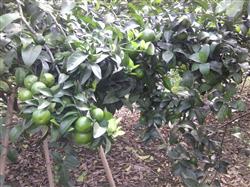What is magnesium deficiency in citrus? How to fix it?

What is magnesium deficiency in citrus? How to fix it? Please give guidance on the occurrence of magnesium deficiency in citrus all the year round, but it occurs most frequently in late summer or autumn when the fruit is about to mature, and the old leaves and leaves near the fruit first show obvious symptoms of magnesium deficiency. This is because when magnesium is deficient in oranges, magnesium in older organs is often transferred to young organs that are growing, so that magnesium deficiency in older organs is often more serious. Magnesium deficiency leaves produce irregular yellow spots along both sides of the midvein, and then the yellow spots spread to the leaf margin, resulting in most of the leaves yellowing, only the leaf veins and the leaf tissue at the base are triangular green. When magnesium deficiency is serious, the leaves are all yellowed and easy to fall off. Deciduous branches grow weak and often die in the following spring. General fruit seedless varieties are more prone to magnesium deficiency than seedless or seedless varieties. citrus magnesium deficiency disease search is as follows: 1. The leaf flesh is yellowed and the leaf vein is green. The old leaves gradually yellowed along both sides of the main and lateral veins, expanding to yellow in the whole leaf, and only the main vein and its tissue remained green. The regularity of magnesium deficiency: the requirement of magnesium in citrus is much larger than that of other trace elements. Because magnesium is easily lost in acidic soil (pH5.0) and sandy soil, citrus is easy to show magnesium deficiency in these soils. When applying too much potassium and phosphorus fertilizer, it is also easy to cause excessive use of sulfur and stone-sulfur mixture in orchard, and it is also easy to make the soil acidic and lead to magnesium deficiency. In the orchard with magnesium deficiency, proper application of magnesium salt on the basis of improving soil and adding organic fertilizer can effectively control magnesium deficiency. (1) soil application. In acidic soils (below pH6.0), magnesium lime (0.75-1kg per fruit tree) should be applied to neutralize soil acidity, and magnesium sulfate should be applied in slightly acidic to alkaline soils. These magnesium salts can be mixed in composting. The high effective concentration of potassium and calcium in the soil will inhibit the absorption of magnesium by the plant, and the application rate of magnesium fertilizer must be increased. In addition, to increase the application of organic matter and salted fish salt, it is also necessary to apply more lime in acidity. (2) spraying 2%-3% magnesium sulfate 3 times from June to July can restore the tree potential, and foliar spraying is effective for mild magnesium deficiency. Click to get more citrus planting techniques click to get more fruit planting techniques
- Prev

What are the fertilization methods for growing oranges?
What are the fertilization methods for growing oranges? Please give an introduction to the following fertilization methods for citrus planting: (1) Root application: most of the citrus roots are distributed in the soil layer of the drip line on the outer edge of the crown, and the location of fertilization should be in the soil of the drip line outside the crown. The depth of fertilization is generally 20-40 cm.
- Next

How to protect the fruit of autumn dry oranges?
How to protect the fruit of autumn dry oranges? Please introduce the autumn dry citrus can refer to the following methods to protect the fruit: first, the orange orchard with irrigation conditions can be irrigated in the afternoon, the water depth is slightly lower than the border surface, through the infiltration of one night, the excess water from the garden will be discharged the next morning to avoid high heat at noon and root damage; no irrigation.
Related
- Moge, come on! The staff of the peasant association in the producing area of cantaloupe were frightened when the crowd gathered.
- Causes and Solutions of low Fruit setting rate of Apple
- Symptoms and control measures of passion fruit virus disease
- Fruit growing lesson: how do apple orchards keep high yields?
- Can you build orchards in the mountains? What are the pros and cons?
- How to manage the coloring period of Crisson grape?
- This paper introduces the processing technology of two kinds of fig products.
- How much is a month for retired teachers in rural areas by 2020?
- How can strawberry planting increase sugar content? We should pay attention to management in many aspects.
- What are the cultivation techniques on how to improve the yield of golden fruit?

